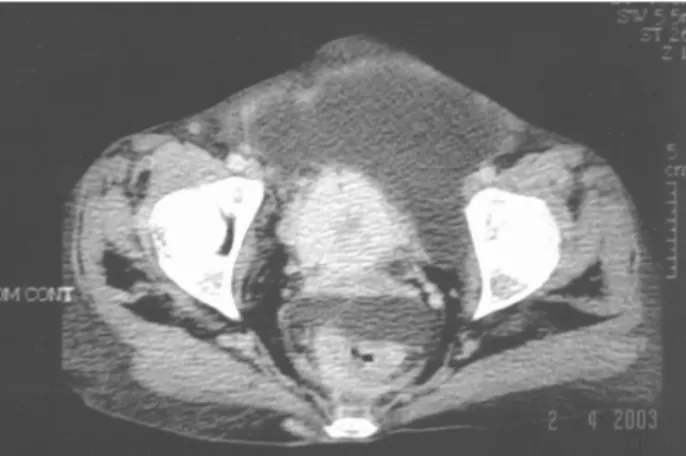403
VESICAL METASTASIS OF GASTRIC ADENOCARCINOMA Case Report
International Braz J Urol
Official Journal of the Brazilian Society of Urology
Vol. 30 (5): 403-405, September - October, 2004
VESICAL METASTASIS OF GASTRIC ADENOCARCINOMA
ALBERTO A. ANTUNES, TIBÉRIO M. SIQUEIRA JR, EVANDRO FALCÃO
Service of Urology, Getúlio Vargas Hospital, Recife, Pernambuco, Brazil
ABSTRACT
Metastatic vesical tumors are rare, and constitute approximately 1% of all neoplasias affect-ing this organ. The authors report the case of a 63-year old woman with vesical metastasis of gastric adenocarcinoma.
Patient presented signs of cachexia and complained of left lumbar pain and dysuria unre-sponsive to antibiotic therapy for approximately 5 months. She reported a previous partial gastrec-tomy due to ulcerative undifferentiated gastric adenocarcinoma 1 year and 9 months before.
Cystoscopy revealed an extensive vegetative lesion in bladder, occupying its entire mucosal surface. The biopsy revealed metastatic signet-ring cell adenocarcinoma.
Key words: bladder; metastasis; gastric cancer Int Braz J Urol. 2004; 30: 403-5
INTRODUCTION
In Brazil, bladder cancer is the fourth more frequent neoplasia in men, and the second most preva-lent urogenital neoplasia. Bladder tumors can be pri-mary or metastatic. Metastatic tumors are rare, and constitute approximately 1% of all neoplasias affect-ing this organ (1).
Signs and symptoms resulting from second-ary vesical involvement are present in approximately 20% of cases and the majority of information rela-tive to such cases derives from autopsy studies (2).
The authors report the case of a 63-year old woman with vesical metastasis of gastric adenocar-cinoma.
CASE REPORT
FMS, 63 years old, complained of left lumbar pain and dysuria unresponsive to antibiotic therapy for approximately 5 months. She also reported weight loss that was not quantified during this period.
Physical examination revealed enlarged and ascitic abdomen, without palpable masses, and pain-ful at lower abdomen. She reported a previous partial gastrectomy 1 year and 9 months before, due to ul-cerative undifferentiated gastric adenocarcinoma that reached the organ’s serosa.
Serum creatinine on presentation was 3.5 mg/ dL. Urine culture was negative. She underwent a cys-toscopy that revealed an extensive vegetative lesion in bladder, practically occupying the entire mucosal surface. There were no necrotic areas or signs of uri-nary infection. A biopsy of the vesical lesion was per-formed.
Abdominal computerized tomography evi-denced bilateral hydronephrosis and voluminous as-cites (Figure-1). Bladder presented thickened wall, suggesting tumoral process (Figure-2). Chest x-ray normal. The pathological analysis of the biopsy speci-men revealed metastatic signet-ring cell adenocarci-noma (Figure-3).
404
VESICAL METASTASIS OF GASTRIC ADENOCARCINOMA
day with symptomatic medication and conservative treatment. She presented stable condition after an 8-month follow-up.
COMMENTS
Vesical metastases of gastric carcinoma cor-respond to approximately 1% of all neoplasias affect-ing bladder and, in 31% of cases, the primary focus is stomach (1).
Figure 1 – Abdominal computerized tomography showing
bilat-eral hydronephrosis and voluminous ascites.
Figure 2 – Pelvic computerized tomography showing thickened
bladder wall, suggesting tumoral infiltration.
Figure 3 – Photomicrography showing infiltration of signet-ring
cell adenocarcinoma in bladder wall (HE, X250), detail with mag-nification X400.
Among cases of metastatic vesical tumors published to the moment, the incidence is similar between genders, and mean age ranges from 44 to 63 years (3).
Potential mechanisms that can contribute for the development of secondary bladder lesions are di-rect extension of the primary focus, implant of exfo-liated cells from ureter and renal pelvis, and lym-phatic, hematogenic or peritoneal dissemination from a distant focus (2).
In our patient, urinary symptoms motivated the performance of complementary exams such as cystoscopy and abdominal computerized tomography, which resulted in the diagnosis of metastatic bladder tumor. Generally speaking, treatment with curative intention is not possible due to the metastatic charac-teristic of the disease, and adjuvant chemotherapy is indicated in some cases, though with unsatisfactory results.
After diagnosing a bladder adenocarcinoma, we must keep in mind the possibility of primary stomach or colon lesions, since in a few cases this can be the first clinical manifestation in these pa-tients.
REFERENCES
405
VESICAL METASTASIS OF GASTRIC ADENOCARCINOMA
al.: Bladder metastasis of signet-ring cell adenocarci-noma from the stomach. Arch Esp Urol. 2000; 53: 839-41.
2. Leddy FF, Peterson NE, Ning TC: Urogenital linitis plastica metastatic from stomach. Urology. 1992; 39: 464-7.
3. Saba NF, Hoening DM, Cohen SI: Metastatic signet-ring cell adenocarcinoma to the urinary bladder. Acta Oncol. 1997; 36: 219-20.
Received: February 16, 2004 Accepted after revision: July 19, 2004
Correspondence address: Alberto Azoubel Antunes R. Três de Maio, 17 / 31 04044-020, São Paulo, SP
